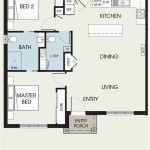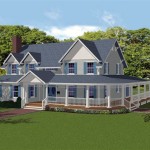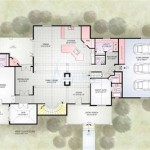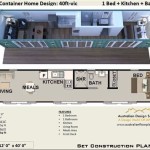The Enduring Appeal of Open Concept Floor Plans
Open concept floor plans have revolutionized residential architecture, transforming how people interact with their living spaces. This design philosophy, characterized by the absence of walls separating primary living areas such as the kitchen, living room, and dining room, has become a dominant trend in contemporary home design. Understanding the nuances of open concept living, its advantages, potential drawbacks, and variations is crucial for homeowners considering this architectural style.
Key Advantages of Open Concept Living
The popularity of open concept floor plans stems from a multitude of advantages that cater to modern lifestyles. These advantages extend beyond aesthetics, impacting functionality, social interaction, and overall perceived spaciousness.
One primary benefit is the enhanced sense of spaciousness. By removing interior walls, natural light can permeate the entire living area, creating a brighter and more airy atmosphere. This is particularly beneficial in smaller homes, where the illusion of a larger space can significantly improve the perceived comfort and livability. The absence of visual barriers allows the eye to travel freely, contributing to a sense of openness and freedom.
Another significant advantage is the improved flow and functionality of the living space. An open concept layout facilitates seamless transitions between different activities, making it ideal for entertaining guests, supervising children, or simply enjoying a relaxed evening at home. The uninterrupted space encourages interaction and communication, fostering a sense of connection among family members or guests.
Furthermore, open concept designs offer greater flexibility in furniture arrangement and interior design. Without the constraints of fixed walls, homeowners have more freedom to customize the layout to suit their individual needs and preferences. This adaptability is particularly valuable in homes that need to accommodate changing lifestyles or family dynamics. The open space can be easily reconfigured to create different zones for various activities, such as a home office, a play area, or a reading nook.
Finally, open concept homes often have a higher resale value compared to traditional homes with compartmentalized layouts. The modern aesthetic and functional benefits of open concept designs appeal to a wider range of buyers, making them a desirable feature in the real estate market. The perceived spaciousness and adaptability of open concept homes can be a significant selling point, particularly for families and individuals who value social interaction and flexible living spaces.
Potential Drawbacks and Considerations
While open concept living offers numerous benefits, it is essential to acknowledge the potential drawbacks and challenges associated with this design style. These considerations must be carefully weighed before committing to an open concept floor plan to ensure that it aligns with the individual's lifestyle and preferences.
One significant challenge is the issue of noise control. Without walls to buffer sound, noise can travel freely throughout the open living area, potentially disrupting activities such as working, reading, or sleeping. This can be particularly problematic in households with multiple occupants or individuals who require quiet spaces for focused work or relaxation. Effective soundproofing measures, such as using acoustic panels, rugs, and soft furnishings, may be necessary to mitigate noise pollution in open concept homes.
Another potential drawback is the lack of privacy. The absence of walls can make it difficult to create private spaces for individual activities or conversations. This can be particularly challenging in households with teenagers or individuals who value their personal space. Strategies for creating privacy in open concept homes include using strategically placed furniture, screens, or room dividers to delineate different zones and provide visual separation.
Furthermore, maintaining cleanliness and organization in an open concept space can be more demanding compared to traditional homes with compartmentalized layouts. The absence of walls means that clutter and mess are more visible, requiring a greater commitment to regular cleaning and organization. Effective storage solutions, such as built-in cabinets and shelving, are essential for keeping the open living area tidy and clutter-free.
Finally, heating and cooling an open concept home can be less efficient than a traditional home with enclosed rooms. The larger volume of space requires more energy to heat or cool, potentially resulting in higher utility bills. Strategies for improving energy efficiency in open concept homes include using energy-efficient windows and insulation, installing smart thermostats, and employing zoning systems to control temperature in different areas of the house.
Variations and Adaptations of Open Concept Design
Open concept design is not a monolithic style, but rather a flexible framework that can be adapted and customized to suit individual preferences and site-specific conditions. Various variations and adaptations of open concept design have emerged, offering different degrees of openness and incorporating elements of traditional design principles.
One common variation is the "partial open concept" layout, which retains some interior walls to define distinct zones while still maintaining a sense of openness and flow. This approach allows for a balance between open living and privacy, providing visual connection between living spaces while also offering defined areas for specific activities. For example, a partial wall might separate the kitchen from the living room, allowing for visual interaction while also providing a degree of separation and acoustic buffering.
Another adaptation is the incorporation of flexible partitions or movable walls that can be used to temporarily divide the open living area into smaller, more private spaces. These partitions can be easily opened or closed as needed, providing maximum flexibility and adaptability. Examples of flexible partitions include sliding doors, folding screens, and curtains, which can be used to create temporary walls or visual barriers.
Furthermore, some open concept designs incorporate changes in elevation to define different zones within the open living area. For example, a slightly raised platform might be used to delineate the dining area from the living room, creating a subtle visual separation without completely obstructing the view. Changes in elevation can also be used to create interesting architectural features and add visual interest to the open space.
Finally, the integration of natural elements, such as indoor plants, water features, and green walls, can enhance the sense of openness and connection to the outdoors in open concept homes. These elements can help to soften the hard edges of the interior and create a more inviting and relaxing atmosphere. The use of natural materials, such as wood and stone, can also contribute to a sense of warmth and connection to nature.
Ultimately, the success of an open concept floor plan depends on careful planning, thoughtful design, and a clear understanding of the homeowner's needs and lifestyle. By considering the advantages, potential drawbacks, and available variations, homeowners can create an open concept living space that is both functional and aesthetically pleasing.
Open concept designs, when executed well, promote connectivity and shared experiences. Kitchen islands often become central gathering spots, facilitating conversation while preparing meals. Sightlines remain unobstructed, allowing for greater supervision of children at play or easy interaction with guests. Large windows, a common feature in these designs, bring in natural light and connect the interior with the outdoors, further enhancing the feeling of spaciousness.
Careful attention to detail is critical when selecting finishes and materials for an open concept space. Because all the elements are visible within a single view, a cohesive design scheme is crucial. This means selecting flooring, paint colors, and furniture that complement each other and create a unified aesthetic. Maintaining a consistent style throughout the open area helps to avoid a disjointed or cluttered appearance.
Smart storage solutions are also paramount. Because clutter is more noticeable in an open space, it is essential to incorporate ample storage options to keep belongings organized and out of sight. Built-in cabinetry, shelving units, and hidden storage compartments can help to maximize space and minimize clutter. Regular decluttering is also necessary to maintain a clean and organized living environment.

Pros And Cons Of An Open Concept Floor Plan Generation Homes Nw

Why Open Concept Floor Plans Because They Work

Your Open Concept Floor Plan Here S How To Fix It Laurel Home

House Design Trends What S Popular In Cur Floor Plans Extra Space Storage

Modern Open Floor House Plans Blog Eplans Com

Open Concept Ranch Floor Plans Houseplans Blog Com
:max_bytes(150000):strip_icc()/1660-Union-Church-Rd-Watkinsville-Ga-Real-Estate-Photography-Mouve-Media-Web-9-77b64e3a6fde4361833f0234ba491e29.jpg?strip=all)
18 Open Floor House Plans Built For Entertaining

Open Concept Ranch Floor Plans Houseplans Blog Com

Free Editable Open Floor Plans Edrawmax

Considerations For Choosing An Open Concept Vs Traditional Floorplan








